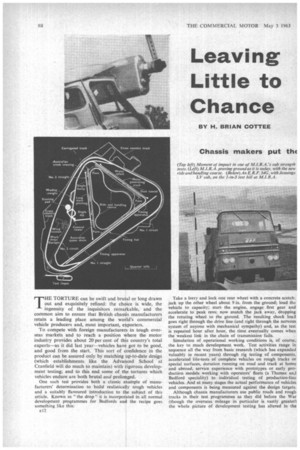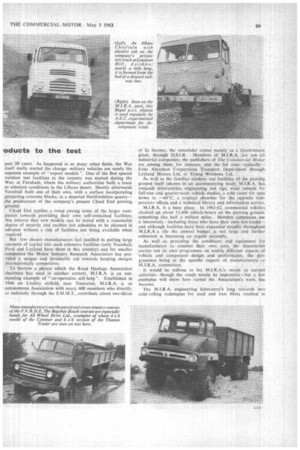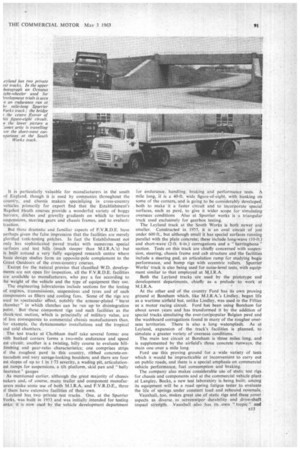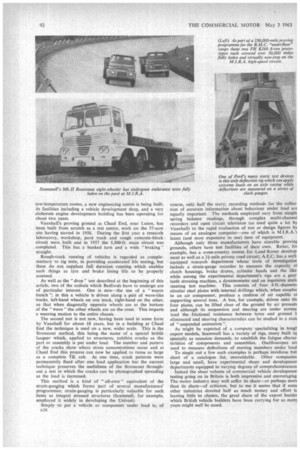Leaving Little to Chance
Page 90

Page 91

Page 92

Page 93

Page 94

If you've noticed an error in this article please click here to report it so we can fix it.
BY H. BRIAN COTTEE
Chassis makers put thc
.oducts to the test THE TORTURE can be swift and brutal or long drawn out and exquisitely refined: the choice is wide, the ingenuity of the inquisitors remarkable, and the common aim to ensure that British chassis manufacturers retain a leading place among the world's commercial vehicle producers and, most important, exporters.
To compete with foreign manufacturers in tough overseas markets and to reach a position where the motor industry provides about 20 per cent of this country's total exports—as it did last year—vehicles have got to be good, and good from the start. This sort of confidence in the product can be assured only by matching up-to-date design (which establishments like the Advanced School at Cranfield will do much to maintain) with rigorous development testing; and to this end some of the tortures which vehicles endure are both brutal and prolonged.
One such test provides both •a classic example of manufacturers' determination to build realistically tough vehicles and a suitably flavoured introduction to the subject of this article. Known as "the drop" it is incorporated in all normal development programmes for Bed fords and the recipe goes something like this:
e12 Take a lorry and lock one rear wheel with a concrete scotch: jack up the other wheel about 9 in. from the ground; load the vehicle to capacity; start the engine, engage first gear and accelerate to peak revs; now snatch the jack away, dropping the rotating wheel to the ground. The resulting shock load goes right through the drive line (and right through the nervous system of anyone with mechanical sympathy) and, as the test is repeated hour after hour, the time eventually comes when the weakest link in the chain of transmission faits.
Simulation of operational working conditions is, of course, the key to much development work. Test activities range in sequence all the way from basic research (which has expanded valuably in recent years) through rig testing of components, accelerated life-tests of complete vehicles on rough tracks or special surfaces, duration running on road and track at home and abroad, service experience with prototypes or early production models working with operators' fleets (a Thames an...I Bedford speciality) to individual testing of production-line vehicles. And at many stages the actual performance of vehicles and components is being measured against the design targets.
Although chassis manufacturers use public roads and rough tracks in their test programmes as they did before the War (though the overseas mileage in particular is vastly greater) the whole picture of development testing has altered in the past 20 years. As happened in so many other fields, the War itself really started the change: military vehicles are surely the supreme example of "export models ". One of the first special outdoor test facilities in the country was started during the War, at Farnham, where the military, authorities built a track to simulate conditions in the Libyan desert. Shortly afterwards Vauxhall built one of their own, with a surface incorporating projecting concrete blocks, in a deserted Hertfordshire quarry— the predecessor of the company's present Chaul End proving ground.
Chaul End typifies a trend among some of the larger companies towards providing their own self-contairied facilities; this ensures that new models can be tested with a reasonable degree of security and enables test schedules to be planned in advance without it risk of facilities not being available when required.
But few chassis manufacturers feel justified in putting large amounts of capital into such extensive facilities (only Vauxhall, Ford and Leyland have them in this country) and for smaller companies the Motor IndustryResearch Association has provided a unique and invaluable aid towards keeping designs internationally competitive.
To borrow a phrase which the Road Haulage Association chairman has used in another context, M.I.R.A. is an outstanding example of "co-operative self-help ". Established in 1946 on Lindley airfield, near Nuneaton, M.I.R.A, is an autonomous Association With neary 600 members who directly, or indirectly through the S.M.M.T., contribute about two-thirds of its income; the remainder comes mainly as a Government
grant, through D.S.1.R. Membersof. M.1,R,A.. are not all industrial companies; the publishers of The Coinmercio! Motor are among them, for instance, and the list runs—typically-from Aberdeen Corporation Transport Department through Leyland Motors Ltd: to Young Windows Ltd..
As As well as the familiar outdoor test facilities af the proving ground itself (shown in' an accompanying. map), M.T.R.A, has research laboratories, engineering test rigs., wind. tunnels for full-size and quarter,scale vehicle studies, a Cold room for tests down to —60°C, a, tropical chamber for the opposite temperature effects and. a technical library and information service.
MIRA. is a busy place. In .1961-62, commercial vehicles clocked up about 11,400 vehicle-hours on the proving ground, something like half a million miles. Member companies use it intensively --including those who have their own test tracks-and although facilities have been expanded steadily throughout M.I.R.A.'s life the annual budget is not large and further extension is becoming an urgent necessity.
: As well -as providing the . conditions and equipment for manufacturers to conduct. their own . tests, the Association carries out its own programme on widely different aspects of -vehicle and component design and performance, the programmes being at the specific request of manufacturers or M.I.R.A. committees.
It would be tedious to list M.I.R.A.!s recent or current activities—though the result would be impressive—but a few examples will show how varied the Association's work. has become. • • The M.I.R.A. engineering laboratory's long research into cold-rolling techniques for steel and iron fillets resulted in
improvements of up to 100 per cent in fatigue strength and their techniques are now being fairly widely adopted in industry. The Association's research into brake squeal has, in just one application, resulted in over 60,090 units being made by a member company, under M.I.R.A, licence, for prevention of brake squeal in buses. To examine the influence of road salt on vehicle corrosion, test panels representing 12 different materials or finishes have been attached for two winter seasons to the underside of some London buses, for one winter on the underside of motorway coaches and on MI salt-spreading lorries and, for a short period, to vehicles used on seashore patrol at Southport. Initial results showed about equal corrosion in one year on motorway coaches as in two years on London buses; that London buses' test panels showed only slightly more corrosion on salt-treated routes than on untreated routes; and that the salt-spreaders' panel showed much higher corrosion than the coaches' panels.
Then there are turbocharged engine performance tests in which, after discussion with engine and turbocharger manufacturers, a programme was drawn up in which greater emphasis was placed on higher degrees of supercharge at lower engine speeds. And a current programme is examining diesel oil filter design with rigs showing, for example, the pressure drop through a given filter with different sizes ot contaminating particles in the fuel.
Three researches allied to legislation which have been going ahead with some urgency are into vehicle noise, atmospheric pollution by petrol engines, and commercial vehicle cab design.
The latter has particular significance because of Swedish regulations concerning cab strength, and M.I.R.A. has been using two rigs—for impact and for crushing strength tests. This is an example of how a co-operative body such as M.I.R.A. can perform for the industry vital test functions which it would be both prohibitively expensive and extremely wasteful for each chassis maker to undertake on his own account.
Vehicle noise, too, is a matter of some urgency with legislation in the offing, and special Danish equipment is being used in a carefully calibrated test area at M.I.R.A. to measure noise levels and establish the principal "decibel sources" on different types of commercial chassis.
The varied work on the proving ground itself is by now well known and it has become a matter of routine for most manufacturers to run endurance and performance tests with new chassis on the high-speed circuit, ride, durability and handling tests on the special surfaces and on the new handling course, and on the notorious pave. Although some manufacturers, particularly in the North, have local open-road circuits of greater general severity than MIRA. (such as Seddon's own favourite 20-mile hilly run in the Oldham area) the use of Lindley's pave provides a valuable standard test; experience built up over the years now enables makers to equate " x " miles on the pave with "y" miles of service use overseas, with a fair degree of confidence.
But KI.R.A. is not the only "open house" for testing in Britain.
One of the outstanding features of post-war vehicle testing in Britain has been the active co-operation of the military authorities, exemplified in practice by the Fighting Vehicles Research and Development Establishment (known universally as F.V.R.D.E.) at Chobham in Surrey. For some manufacturers this co-operation was a natural outcome of wartime associations entered into for military transport developments—and some, of course, are still engaged in military vehicle work— but the way in which F.V.R.D.E., and its predecessor organizations prior to 1952, has put its experience and facilities at the disposal of the industry has earned the Establishment warm regard.
ft is particularly valuable for manufacturers in the south of England, though it is used by companies throughout the country, and chassis makers specializing in cross-country vehicles primarily for export find that the Establishment's Bagshot Heath courses provide a wonderful variety of boggy horrors, ditches and gravelly gradients on which to torture suspensions, steering gears and chassis frames, and to evaluat...: traction.
But these dramatic and familiar aspects of F.V.R.D.E. have perhaps given the false impression that the facilities are merely glorified tank-testing patches. In fact the Establishment not only has sophisticated paved tracks with numerous special surfaces and test hills (much steeper than M.I.R.A.'s) but is built around a very fully equipped research centre where basic design studies form an opposite-pole complement to the Great Outdoors of the cross-country courses.
Except for the natural proviso that classified W.D. developments are not open for inspection, all the F.V.R.D.E. facilities are available to manufacturers, who pay a fee according to the weight of the vehicle and the type of equipment they use.
The engineering laboratories include sections for the testing of engines, transmissions, suspensions and tyres and of such components as filters and cooling fans. Some of the rigs are used to spectacular effect, notably the armour-plated "burst chamber" in which clutches can be run up to disintegration point. But these component rigs and such facilities as the shock-test. section, which is principally of military value, are of less consequence to commercial chassis manufacturers than, for example, the dynamometer installations and the tropical and cold chambers.
The test tracks at Chobham itself take several forms: one mith banked corners forms a two-mile endurance and speed est circuit; another is a twisting, hilly course to evaluate hill:limbing and gear-ratio characteristics; one comprises strips lf the roughest pave in this country, ribbed concrete-onnacadam and very savage-looking boulders; and there are four est slopes of up to 1 in 1.73 severity, a wading pit, articulation. est ramps for suspensions, a tilt platform, skid pan and " belly :learance" gauges As mentioned earlier, although the great majority of chassis nakers and, of course, many trailer and component manufacurers make some use of both M.I.R.A. and F.V.R.D.E., three A them have extensive facilities of their own. • Leyland has two private -test tracks. One, at the Spurrier Yorks, was built in 1953 and was initially intended for testing anks; it is now used by, the vehicle development department for endurance. handling, braking and performance tests. A mile long, it is a 40-ft. wide figure-of-eight, with banking on some of the corners, and is going to be considerably developed, both to make it a faster circuit and to incorporate special surfaces, such as pave, to give it wider scope for simulating' overseas conditions Also at Spurrier works is a triangular track used exclustvely for gearbox testing.
The Leyland track at the South Works is both newer and smaller. Constructed in 1955, it is an oval circuit of just under 600 ft., but although small it has special surfaces running parallel with the plain concrete; these include long-wave (10-ft.) and short-wave (2-ft. 6-in.) corrugations and a "herringbone" section. Tests on this track are chiefly concerned with suspension, steering, chassis frame and cab structure and the facilities include a steering pad, an articulation ramp for studying bogie performance, and bump rigs with eccentric rollers. Spurrier Works' track is also being used for noise-level tests, with equipment similar to that employed at M.I.R.A.
Both the Leyland tracks are used by the prototype and development departments, chiefly as a prelude to work at M.I.R.A.
At the other end of the country Ford has its own proving ground at 13oreham which, like M.I.R.A.'s Lindley, began life as a wartime airfield but, unlike Lindley, was used in the Fifties• as a motor racing circuit. Ford ha S been using Boreham for about seven years and has transformed it by the addition of special tracks simulating the ever-(un)popular Belgian pave and the washboard corrugations found in many of the rougher overseas territories. There is also a long watersplash. As at Leyland, expansion of the track's • facilities is planned, to simulate a greater variety of overseas conditions.
The main test circuit at Boreham is three miles long, and is supplemented by the airfield's three concrete runways, the main one over a mile long Ford use this proving ground for a wide variety of tests which it would be impracticable or inconvenient to carry out on public roads, and there is a special emphasis on commercial vehicle performance, fuel consumption and braking.
The company also makes considerable use of static test rigs for chassis and components and at the commercial vehicle plant at Langley, Bucks, a new test laboratory is being built; among its equipment will be a road spring fatigue tester to evaluate the life of springs under constant load and rebound reversals.
Vauxhall. too, makes great use of static rigs and these cover aspects as diverse., as screenwiper durability and drive-shaft impact strength-. -Vauxhall -also .has its.aawn tropic " and
low-temperature rooms, a new engineering centre is being built, its facilities including a vehicle development shop, and a very elaborate engine development building has been operating for about two years.
Vauxhall's proving ground at Chaul End, near Luton, has been built from scratch as a test centre, work on the 57-acre site having started in 1956. During the first year a research laboratory, workshop, pav6 track and rough concrete-block circuit were built and in 1957 the 5,500-ft. main circuit was completed. This has a banked turn and a wide "braking straight.
Rough-track running of vehicles is regarded as complementary to rig tests, in providing accelerated life testing, but these do not supplant full duration running which enables such things as tyre and brake lining life to be properly assessed.
As well as the "drop" test described at the beginning of this article, two of the ordeals which Bedfords have to undergo are of particular interest. One is new—the use of a "weave trench"; in this a vehicle is driven along a pair of wave-like tracks, left-band wheels on one track, right-hand on the other, so that when diagonally opposite wheels are at the bottom of the " wave " the other wheels are on the crest. This imparts a weaving motion to the entire chassis.
The second test is not new, having been used in some form by Vauxhall for about 18 years. but in a building at Chaul End the technique is used on a new, wider scale. This is the Stresscoat method, this being the name of a special brittle lacquer which, applied to structures, exhibits cracks as the part or assembly is put under load. The number and pattern of the cracks show where stress concentrations occur and at Chaul End this process can now be applied to items as large as a complete TK cab. At one time, crack patterns were permanently fixed after one load application but the current technique preserves the usefulness of the Stresscoat throughout a test in which the cracks can be photographed spreading as the load is increased.
This method is a kind of " all-over " equivalent of the strain-gauging which forms part of several manufacturers' programmes; strain-gauging is particularly valuable for such items as integral stressed structures (Scammell, for example, employed it widely in developing the Univan).
Simply to put a vehicle or component under load is, of E16 course, only half the story; recording methods for the collection of accurate information about behaviour under load are equally important. The methods employed vary from simple spring balance readings, through complex multi-channel recorders and open circuit television (as used quite a lot by Vauxhall) to the rapid evaluation of test or design figures by means of an analogue computer—one of which is M.I.R.A.'s latest (and most expensive to use) item of equipment. Although only three manufacturers have sizeable provins grounds, others have test facilities of their own. Rover, foi example, has a cross-country course for Land-Rover develop ment as well as a 21-mile private road circuit; A.E.C. has a well equipped research department whose tools of investigatior include a strain-gauge recorder to measure the capacity ol clutch housings, brake drums, cylinder heads and the like while among the experimental department's rigs are a gear. teeth stressing machine, a dynamometer and an ingenious static steering test machine. This consists of four 4-ft.-diametel circular steel plates with internal drillings which, when couplec to an air compressor. produce a cushion of air capable ol supporting several tons. A bus, for example, driven onto thc four plates, can be lifted clear of the ground by air pressun and although its suspension and steering are under norrna load the frictional resistance between tyres and ground i! eliminated and steering characteristics can be studied in a state of "suspended animation ".
As might be expected of a company specializing in tougt export models, Scammell has a variety of rigs, many built us specially as occasion demands, to establish the fatigue charac teristics -of components and assemblies. Oscilloscopes an used to measure deflections of moving members under load
To single out a few such examples is perhaps invidious but short of a catalogue list, unavoidable. Other companies large and small, have experimental shops and developrneni departments equipped to varying degrees of comprehensiveness Indeed the sheer volume of commercial vehicle developmen. testing going on in Britain is both impressive and encouraging The motor industry may well suffer its share—or perhaps mon than its share—of criticism, but to me it seems that if somt other industries devoted half as much money and effort tc leaving little to chance, the great share of the export burder which British vehicle builders have been carrying for so many years might well be eased.




















































































































































































































































